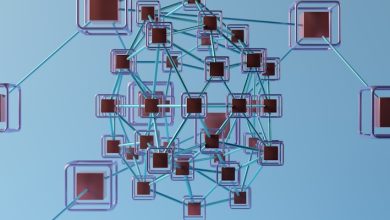Security Challenges in Decentralized Networks

- Understanding the Threat Landscape in Decentralized Networks
- The Role of Blockchain Technology in Enhancing Security Measures
- Challenges of Maintaining Privacy and Anonymity in Decentralized Networks
- Mitigating Risks of Double Spending and Sybil Attacks
- The Importance of Consensus Mechanisms in Securing Decentralized Networks
- Future Trends and Innovations in Decentralized Network Security
Understanding the Threat Landscape in Decentralized Networks
Decentralized networks present a unique set of challenges when it comes to cybersecurity. Understanding the threat landscape in these networks is crucial for developing effective security measures.
One of the main concerns in decentralized networks is the risk of malicious actors gaining control and compromising the integrity of the network. This can lead to data breaches, unauthorized access, and other security incidents.
Another key issue is the lack of a centralized authority to monitor and enforce security protocols. This decentralized nature makes it difficult to detect and respond to security threats in a timely manner.
Furthermore, the use of blockchain technology in decentralized networks introduces its own set of security vulnerabilities. Smart contracts, for example, can be exploited if not properly secured, leading to financial losses and other consequences.
Overall, a comprehensive understanding of the threat landscape in decentralized networks is essential for mitigating risks and protecting sensitive information. By staying informed and implementing robust security measures, organizations can navigate the challenges posed by decentralized networks and safeguard their data effectively.
The Role of Blockchain Technology in Enhancing Security Measures
Blockchain technology plays a crucial role in enhancing security measures in decentralized networks. By utilizing a decentralized and distributed ledger system, blockchain provides a high level of security by ensuring transparency, immutability, and integrity of data.
One of the key features of blockchain technology is its ability to create a tamper-proof record of transactions through cryptographic hashing. This ensures that once data is recorded on the blockchain, it cannot be altered or deleted without consensus from the network participants. This helps prevent unauthorized access and manipulation of data, thus enhancing the overall security of the network.
Moreover, blockchain technology utilizes consensus mechanisms such as Proof of Work (PoW) or Proof of Stake (PoS) to validate transactions and secure the network against malicious attacks. These consensus mechanisms ensure that only legitimate transactions are added to the blockchain, reducing the risk of fraud and enhancing the overall security of the network.
Additionally, blockchain technology enables the use of smart contracts, which are self-executing contracts with the terms of the agreement directly written into code. Smart contracts help automate processes, eliminate the need for intermediaries, and reduce the risk of human error or manipulation. This further enhances security by ensuring that transactions are executed as intended, without the need for trust between parties.
In conclusion, blockchain technology plays a vital role in enhancing security measures in decentralized networks by providing transparency, immutability, and integrity of data, utilizing consensus mechanisms to validate transactions, and enabling the use of smart contracts to automate processes. By leveraging these features, decentralized networks can enhance their security posture and mitigate the risks associated with centralized systems.
Challenges of Maintaining Privacy and Anonymity in Decentralized Networks
One of the major challenges faced in decentralized networks is the issue of maintaining privacy and anonymity. With data being distributed across multiple nodes, it becomes increasingly difficult to ensure that sensitive information is not exposed to unauthorized parties. This lack of centralization means that traditional methods of data protection, such as firewalls and encryption, may not be as effective.
Furthermore, the decentralized nature of these networks can make it challenging to track and trace malicious actors who may be attempting to breach security protocols. Without a central authority to monitor and regulate network activity, it becomes harder to identify and mitigate potential threats in a timely manner.
Another issue that arises in decentralized networks is the potential for data leakage and unauthorized access. As information is shared and replicated across various nodes, there is an increased risk of data being intercepted or manipulated without the knowledge of the network participants. This can lead to breaches of privacy and confidentiality, which can have serious consequences for individuals and organizations alike.
Mitigating Risks of Double Spending and Sybil Attacks
One of the key security challenges in decentralized networks is the risk of double spending and Sybil attacks. Double spending occurs when a user spends the same digital currency more than once, while a Sybil attack involves a single entity creating multiple fake identities to gain control over the network.
To mitigate these risks, various techniques can be employed. One common approach is the use of consensus algorithms such as Proof of Work (PoW) or Proof of Stake (PoS). These algorithms ensure that transactions are verified by the network before they are added to the blockchain, making it difficult for malicious actors to manipulate the system.
Another strategy is the use of cryptographic techniques to secure transactions and prevent double spending. By using digital signatures and cryptographic hashes, users can prove ownership of their digital assets and ensure that transactions are valid.
Furthermore, network participants can implement mechanisms to detect and prevent Sybil attacks. This can include requiring proof of identity or reputation to access certain parts of the network, as well as monitoring the network for suspicious activity.
Overall, mitigating the risks of double spending and Sybil attacks is essential to ensuring the security and integrity of decentralized networks. By implementing a combination of consensus algorithms, cryptographic techniques, and network monitoring, users can protect their assets and maintain trust in the network.
The Importance of Consensus Mechanisms in Securing Decentralized Networks
Consensus mechanisms play a crucial role in ensuring the security of decentralized networks. These mechanisms are responsible for reaching an agreement among network participants on the validity of transactions. By establishing consensus, decentralized networks can prevent malicious actors from compromising the integrity of the system.
One of the key benefits of using consensus mechanisms is that they help to create a trustless environment where transactions are verified and recorded without the need for a central authority. This decentralized approach makes it challenging for hackers to manipulate the network and carry out fraudulent activities.
There are several types of consensus mechanisms used in decentralized networks, including Proof of Work (PoW), Proof of Stake (PoS), and Delegated Proof of Stake (DPoS). Each of these mechanisms has its strengths and weaknesses, but they all work towards the common goal of securing the network and maintaining its integrity.
Without a robust consensus mechanism in place, decentralized networks would be vulnerable to various security threats, such as double-spending attacks and Sybil attacks. These threats could undermine the trust and reliability of the network, ultimately leading to its downfall.
In conclusion, consensus mechanisms play a critical role in securing decentralized networks and ensuring their continued operation. By establishing a consensus among network participants, these mechanisms help to maintain the integrity and trustworthiness of the network, making it resistant to malicious attacks and ensuring the security of transactions.
Future Trends and Innovations in Decentralized Network Security
The future of decentralized network security is promising, with new trends and innovations on the horizon. One key development is the rise of blockchain technology, which offers a secure and transparent way to store data and transactions. By utilizing blockchain, decentralized networks can enhance their security measures and protect against cyber threats more effectively.
Another trend to watch out for is the use of artificial intelligence and machine learning in decentralized network security. These technologies can help analyze vast amounts of data in real-time, identifying potential security risks and responding to them promptly. By incorporating AI and ML into their security protocols, decentralized networks can stay one step ahead of cyber attackers.
Moreover, the adoption of zero-trust security models is gaining traction in decentralized networks. This approach assumes that no entity, whether inside or outside the network, can be trusted by default. By implementing strict access controls and continuous monitoring, decentralized networks can minimize the risk of unauthorized access and data breaches.
Additionally, the use of decentralized identity management systems is becoming more prevalent in network security. These systems allow users to have greater control over their personal information and credentials, reducing the likelihood of identity theft and fraud. By leveraging decentralized identity solutions, networks can enhance their security posture and build trust with their users.
In conclusion, the future of decentralized network security is bright, with emerging trends and innovations shaping the landscape. By embracing technologies like blockchain, AI, zero-trust security models, and decentralized identity management systems, networks can bolster their defenses and mitigate security risks effectively. As the threat landscape evolves, staying ahead of the curve will be crucial for ensuring the security and integrity of decentralized networks.



